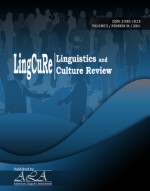Features of Russian-Turkish and Turkish-Russian simultaneous interpretation
Keywords:
context, dialects, grammatical structure, language, linguisticsAbstract
The relevance of the study lies in the fact that nowadays cooperation between countries is constantly developing at different levels, which necessitates the use of simultaneous interpreting services. In order to meet the demands of today's market and above all to live up to the expectations, it is important to understand the special features of Russian-Turkish and Turkish-Russian simultaneous interpretation, regardless of subject matter and degree of complexity. Such interpretation is quite a complex task, since Turkish is a language belonging to the group of languages that is spoken by 83 million people worldwide, mostly in Turkey and Northern Cyprus, where it has the status of an official language. In the Russian Federation there is little knowledge of Turkish, which seems to be the main reason for the growing demand for simultaneous interpreting. The purpose of the study is to conduct a linguistic analysis of Russian-Turkish and Turkish-Russian simultaneous interpretation, which will reveal the features of language structures that influence the choice of strategies and actions in the simultaneous interpretation process.
Downloads
References
Altmann, G., & Steedman, M. (1988). Interaction with context during human sentence processing. Cognition, 30(3), 191-238. https://doi.org/10.1016/0010-0277(88)90020-0
Baugh, J. (1995). The law, linguistics, and education: Educational reform for African American language minority students. Linguistics and Education, 7(2), 87-105. https://doi.org/10.1016/0898-5898(95)90002-0
Bettini, C., Brdiczka, O., Henricksen, K., Indulska, J., Nicklas, D., Ranganathan, A., & Riboni, D. (2010). A survey of context modelling and reasoning techniques. Pervasive and mobile computing, 6(2), 161-180. https://doi.org/10.1016/j.pmcj.2009.06.002
Borris, D. ., & Zecho, C. . (2018). The linguistic politeness having seen on the current study issue. Linguistics and Culture Review, 2(1), 32-44. https://doi.org/10.21744/lingcure.v2n1.10
Canagarajah, S., & De Costa, P. I. (2016). Introduction: Scales analysis, and its uses and prospects in educational linguistics. Linguistics and Education, 34, 1-10. https://doi.org/10.1016/j.linged.2015.09.001
Cargile, A. C., Giles, H., Ryan, E. B., & Bradac, J. J. (1994). Language attitudes as a social process: A conceptual model and new directions. Language & Communication, 14(3), 211-236. https://doi.org/10.1016/0271-5309(94)90001-9
Carlet, L. (1998). GV Chernov's psycholinguistic model in simultaneous interpretation: an experimental contribution.
Chen, Z., & Dong, X. (2010). Simultaneous interpreting: Principles and training. Journal of Language Teaching and Research, 1(5), 714.
Dayter, D. (2018). Describing lexical patterns in simultaneously interpreted discourse in a parallel aligned corpus of Russian-English interpreting (SIREN). In FORUM. Revue internationale d’interprétation et de traduction/International Journal of Interpretation and Translation (Vol. 16, No. 2, pp. 241-264). John Benjamins.
De Vries, M. H., Monaghan, P., Knecht, S., & Zwitserlood, P. (2008). Syntactic structure and artificial grammar learning: The learnability of embedded hierarchical structures. Cognition, 107(2), 763-774. https://doi.org/10.1016/j.cognition.2007.09.002
Gerver, D. (2019). The effects of source language presentation rate on the performance of simultaneous conference interpreters.
Gile, D. (2009). Basic concepts and models for interpreter and translator training (Vol. 8). John Benjamins Publishing.
Hansen-Schirra, S., Neumann, S., & Steiner, E. (2012). Cross-linguistic Corpora for the Study of Translations. De Gruyter Mouton.
Heltai, P., & Lanstyak, I. (2018). Translation and bilingual language use: Two subtypes of bilingual communication.
Jacquemet, M. (2005). Transidiomatic practices: Language and power in the age of globalization. Language & communication, 25(3), 257-277. https://doi.org/10.1016/j.langcom.2005.05.001
Jones, R. (2018). Conference interpreting explained. London: Routledge.
Kraljic, T., Brennan, S. E., & Samuel, A. G. (2008). Accommodating variation: Dialects, idiolects, and speech processing. Cognition, 107(1), 54-81. https://doi.org/10.1016/j.cognition.2007.07.013
Kroll, J. F., & De Groot, A. M. B. (2005). Simultaneous interpreting: a cognitive perspective. In Handbook of Bilingualism (pp. 454-479). Oxford University Press.
Lamber, S., & Moser-Mercer, B. (2018). Bridging the gap: Empirical research on simultaneous interpreting. Amsterdam: John Benjamin Publishing Company.
Menaka, G., & Sankar, G. (2019). The language learning assessment using technology for the second language learners. International Journal of Linguistics, Literature and Culture, 5(4), 1-6. https://doi.org/10.21744/ijllc.v5n4.674
Miller, G. A., Galanter, E., & Pribram, K. H. (2013). Plans and the structure of behavior. New York: Martino Fine Books.
Nan, X. (2020). Analysis of the principles of simultaneous interpreting. Journal of Shaanxi Normal University, 3, 54-61.
Neubert, A., & Shreve, G. (2018). Translation as text. Kent: Kent State University Press.
Peniro, R. ., & Cyntas, J. . (2019). Applied linguistics theory and application. Linguistics and Culture Review, 3(1), 1-13. https://doi.org/10.21744/lingcure.v3n1.7
Rutten, A. (2019). Information and knowledge management in conference interpreting. Frankfurt: Peter Lang.
Savin, H. B., & Perchonock, E. (1965). Grammatical structure and the immediate recall of English sentences. Journal of Verbal Learning and Verbal Behavior, 4(5), 348-353. https://doi.org/10.1016/S0022-5371(65)80070-6
Schmidt, T., & Worner, K. (2014). Exmaralda. In: J. Durand, U. Gut, G. Kristoffersen (Eds.), Handbook on corpus phonology (pp. 402-419). Oxford: Oxford University Press.
Seleskovitch, D., & Lederer, M. (2015). Interpreter pour traduire. Traduire, 232, 141-143. [in French].
Shang, H. (2020). On techniques of simultaneous interpretation. Science and Technology Information, 5, 77-84.
Snelling, D. (1992). Strategies for simultaneous interpreting: From Romance languages into English. Udine: Campanotto.
Sumner, M., & Samuel, A. G. (2009). The effect of experience on the perception and representation of dialect variants. Journal of memory and language, 60(4), 487-501. https://doi.org/10.1016/j.jml.2009.01.001
Tiangco, J. A. N. Z. (2020). Deconstructing the evolving roles of English language educators in the 21st century. International Journal of Linguistics, Literature and Culture, 6(4), 49-61. https://doi.org/10.21744/ijllc.v6n4.905
Widana, I.K., Dewi, G.A.O.C., Suryasa, W. (2020). Ergonomics approach to improve student concentration on learning process of professional ethics. Journal of Advanced Research in Dynamical and Control Systems, 12(7), 429-445.
Zhong, W. (2001). Simultaneous interpreting: Principles and training. Chinese Translators Journal, 22, 303-311.
Zieke, W. (2018). Conditioning your memory. New York: Sterling Publishing.
Published
How to Cite
Issue
Section
Copyright (c) 2021 Linguistics and Culture Review

This work is licensed under a Creative Commons Attribution-NonCommercial-NoDerivatives 4.0 International License.














